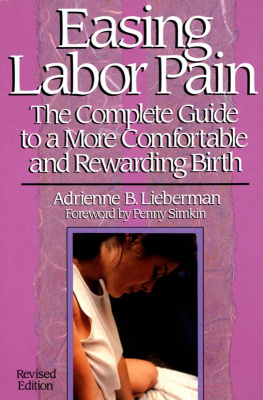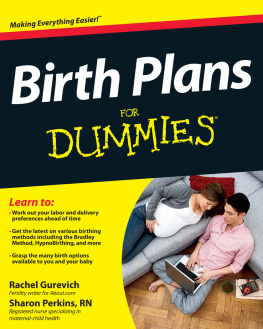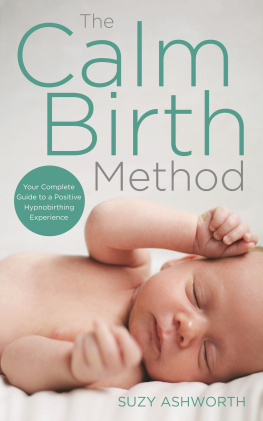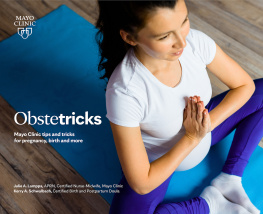To my husband, Syd, in love and appreciation for gifts toonumerous to mention, and to Sarah and Zachary, whose birthswere wonderful despite the pain and who add an irreplaceablezest to my life.
The Harvard Common Press
535 Albany Street
Boston, Massachusetts 02118
Copyright 1992 by Adrienne B. Lieberman
All rights reserved. No part of this publication may be
reproduced or transmitted in any form or by any means,
electronic or mechanical, including photocopy, recording, or
any information storage or retrieval system, without
permission in writing from the publisher.
First edition published in 1987 by Doubleday and Company,
Garden City, New York.
This revised edition published in 1992 by The Harvard
Common Press.
Printed in the United States of America.
Library of Congress Cataloging-in-Publication Data
Lieberman, Adrienne B.
Easing Labor Pain : the complete guide to a more
comfortable and rewarding birth / by Adrienne B.
Lieberman ; foreword by Penny Simkin.Rev. ed.
p. cm.
Includes bibliographical references and index.
ISBN 1-55832-044-X :
ISBN 1-55832-043-1 :
1. Natural childbirth. 2. Therapeutics, Physiological.
I. Title.
RG661.L54 1992
618.4'5dc20 92-382
Illustrations by Jean K. Stephens, Childbirth Graphics,
Rochester, New York
Cover design by Joyce C. Weston
19 18 17 16 15 14 13 12 11 10
Acknowledgments
Thanks to my childbirth students, past and present, whose narratives and birth questionnaires enliven the facts of this book. I also appreciate the cooperation of the parents whom I interviewed in person or over the phone.
Many professionals speak on the following pages. They graciously took time out of their busy schedules to share expertise in acupuncture, acupressure, biofeedback, massage, hypnosis, therapeutic touch, and transcutaneous electrical nerve stimulationsubjects all previously completely exotic to me. Thanks, also, to the professionals who enlightened me on more familiar subjects.
Penny Simkin, physical therapist, author, and childbirth educator, and Suzanna May Hilbers, physical therapist and former national teacher trainer for ASPO/Lamaze, were kind enough to review the entire manuscript of the first edition. Their comments and suggestions proved tremendously helpful. Special thanks to Penny Simkin for writing such a generous foreword to the revised edition.
The revised edition of Easing Labor Pain finally found its true home at The Harvard Common Press. I'm grateful to Lynn Moen of Birth and Life Bookstore in Seattle, who initially suggested The Harvard Common Press, and to my literary agent, Jane Jordan Browne, who oversaw the move. I have thoroughly enjoyed working with editors Dan Rosenberg and Linda Ziedrich, publisher Bruce Shaw, and marketing director Susan Willisall of whom were eminently available, knowledgeable, and enthusiastic about my book.
Foreword
Before the first edition of Easing Labor Pain was published, Adrienne Lieberman approached me at a convention, introduced herself, and asked me to read the manuscript for her book. I was slightly jolted when she told me the titleEasing Labor Painbecause I was planning to write a book on the same subject. I took the manuscript home, and, after convincing myself that there would be room on the market for two books on childbirth pain, I read Adrienne's manuscript. I loved it. It was what I had wanted to write, only much better.
So, in the course of one day, I gave up my plans to write a book. I contacted Adrienne immediately and enthusiastically praised her extensive understanding of the subject, her marvelous writing style, and her fair-minded approach.
Now, for this updated second edition, she has asked me to write a foreword. I am honored, and it should be easy to write a foreword for a book that I admire as much as I do this one. Yet I have wrestled with it. It has not been easy at all, because the whole subject of childbirth pain is so complex. There are many facets to it, and there is no single way to manage this unique pain. My public, professional childbirth educator self tries to be objective and informative, to give fair and complete information to assist prospective parents in making an informed (and therefore correct) decision.
My other self, the experienced mother and labor support person, who has both felt childbirth pain and has helped hundreds of women cope with it, wants to urge you to prepare for and participate in this challenging life transition. Despite the pain and hard work there is much to be gained from experiencing labor and birth fully. The intangible rewardscloseness with those who help you, intense joy, a sense of accomplishment, and enhanced self-esteemare felt to a great degree when you work to have your baby.
Easing Labor Pain is full of tried-and-true ways to develop resources both within and outside yourself, all designed to keep the pain of labor within manageable limits. Learn about them, and use them; they will either get you all the way through or far into your labor. Then, if necessary (as with a long or complicated labor), turn to pain medications and other medical interventions for added help. For many women, this approach to birth brings them more than a baby; it also brings the satisfaction of great accomplishment and a sense of fulfillment that are never forgotten.
Happy Birth Day.
Penny Simkin
Introduction to the Revised Edition
You're going to have a baby. You probably don't know your baby's sex. You certainly don't know your baby's weight, hair color, or personality. There's one thing you can count on, though. Having your baby is likely to be painful.
Your best friend told you the pain was excruciating. "Agony," she said, "until I got my epidural block." Your older sister told you it felt like mild cramping, then medium cramping, then major cramping"like being squeezed in a vise grip"and she even took Lamaze classes. Your mother didn't tell you anything because she didn't want to terrify you. But Carol Burnett revealed that "having a baby is like taking your bottom lip and pulling it over your head."
They're right. Having a baby does hurt. Indeed, that's one thing that hasn't changed at all since this book was first published in 1987.
But lots of other things have changed. Exciting new developments in many aspects of childbearing rendered large parts of several chapters obsolete and dictated the need for a revision of the entire book. In the past five years, for example, we have seen the increased popularity of underwater birth, exercise during pregnancy, single-room maternity care, epidural blocks, and certified nurse-midwives. Traditional delivery rooms and paracervical blocks have practically disappeared.
In addition, as the nation's cesarean rate continued to rise, we applauded as the American College of Obstetricians and Gynecologists revised long-held views on vaginal birth after cesarean and on electronic fetal monitoring. New research vindicated people who recommended female labor support and called into serious question such obstetrical interventions as IVs and episiotomies. In 1989 the American Academy of Pediatrics took a new look at circumcision, cautiously revising its earlier negative stance.
For all these reasons I embraced the opportunity to usher Easing Labor Pain into the 1990s. With the addition of well over 100 new references, some chapters changed a lotthe chapters on obstetric interventions and medication, for exampleand some changed a littlethe chapter on the baby, for example. A few chapterssuch as the chapter on relaxationhardly changed at all. But throughout I have maintained the same purpose I began with in 1987: to help women deal realistically with their fears of labor pain.
Next page








